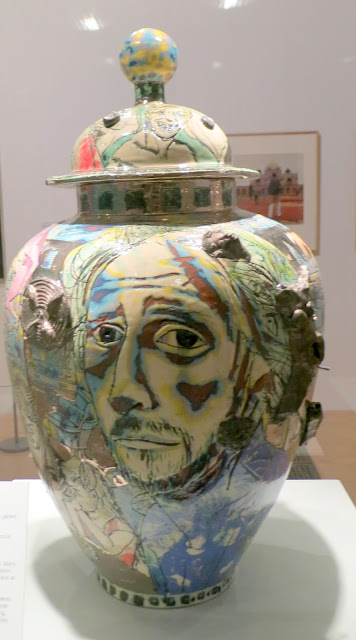Coming Out,
Sexuality, Gender and Identity at the Gas Hall, Birmingham Museum.
This exhibition marks the 50th anniversary of the passing of the Sexual Offences Act 1967. This ruling partially decriminalised sex between some men, in private, in England and Wales. Focusing largely on artworks made from 1967 onwards, this exhibition features over 80 works by modern and contemporary artists.
Keith Vaughan, Harvest Assembly, 1956, (oil on canvas)
Grayson Perry, Claire's Coming Out Dress, 2000
Designed by Perry to mark his emergence as a transvestite to the art world, this dress celebrates the freedom to express yourself as you wish. The dress' embroidered images disrupt the innocence associated with this style of children's dress. Embroidered penises and testicles tied with green ribbons mimic a familiar flower motif, and a hermaphrodite is featured as a butterfly.
Robert Macbryde, Figure and Still Life, 1951, (oil on canvas)
Derek Jarman, Morphine, 1992, (oil paint on photocopies on canvas)
Morphine was made in response to the homophobic outing of a young television actor by a tabloid newspaper in 1992. Photocopies of its front page were stuck to the canvas before Jarman expressed his anger in forcefully applied layers of paint. Jarman was diagnosed as HIV-positive in 1986. Reflecting on this, he wrote: 'I'm not afraid of death but I am afraid of dying. Pain can be alleviated by morphine but the pain of social ostracism cannot be taken away'.
Marvin Gaye Chetwynd, Sexy Collages and Sexy Wallpaper, 2005, (collage on paper, wallpaper)
Karen Knorr, Gentlemen: Men are Interested in Power, Woman are More Interested in Service, 1981-83, (silver bromide print)
Karen Knorr, Gentlemen: Newspapers are no Longer Ironed. Coins no Longer Boiled. So far Standards Have Fallen, 1981-83, (silver bromide print)
The photograph documents a march in Birmingham against the government's decision to not promote anything to do with homosexuality in schools.
Gillian Wearing, The Garden, 1997 (screenprint)
The women in this photograph were brought together by Gillian Wearing. She invited a cross-dresser, a sex-worker and an escort to join her to make this artwork. She asked each of the women to choose a T-shirt to wear from a selection she had brought. Are the statements on the T-shirts they have chosen to wear true of them? The Garden draws attention to the way that a person's public identity is created by the clothes we wear and the way we act.
Mario Dubsky, Xeno, 1983 (charcoal on paper)
The word Xeno means outsider or foreigner.
Linder, and Malcolm Garrett (record sleeve of The Buzzcocks single 'Orgasm Addict', 1977
This record sleeve was designed by Malcolm Garrett and features a collage by Linder of an iron-headed woman. This collage was first created in colour. On the record sleeve the collage is a blue monotone, in keeping with the record company's wish to print the cover in just two colours.
David Hockney, We Two Boys Together Clinging, 1961
This painting was completed during the artist's second year at the Royal College of Art in London. The inspiration for this picture was a poem of the same title by Walt Whitman. Hockney admired Whitman's poems about same-sex desire and love. He said the painting relates to Whitman's idea of 'adhesiveness', a force that creates attachment between men.
David Hockney, Peter Getting Out of Nick's Pool, 1966
Andy Warhol, Marilyn, 1970
and Tracey Emin, When I think about Sex I Think about Men - Women, Dogs, Lions, Group Sex (And I Love you all), 2005
Grayson Perry, Who Am I?, 1996
In Who Am I? Perry directly questions what makes up his own identity. The surface of the pot features images of the artist, a family in a domestic setting, fragmented heads and torsos, abandoned vehicles.
Margaret Harrison, Women of the World Unite, you Have Nothing to Lose but Cheese Cake, 1969
This painting was produced at a time when feminism had begun to radically challenge the gender-imbalance in society.
Harrison's painting mimics the pin-up or 'cheesecake' photography that was common in magazines and advertising at the time she made this work. She used humour and irony to expose and critique how women's bodies were represented in the media.
Sarah Lucas, Nud Cycladic 7, 2010 (tights fluff, wire)
This sculpture is part of a series called Nuds which consist of pairs of tan nylon tights that the artist has stuffed to create abstract forms. In previous artworks, Lucas has used tights and sagging hosiery to resemble female legs and breasts. However, Nud Cycladic 7 is not so easily defined in terms of its references or gender associations. The winding bulbous limbs may resemble a flesh body but also have the appearance of stone.
These photographs challenge traditional depictions of femininity in the media and art history. Lucas says she never endeavoured to be particularly masculine, but she avoided some of the trappings of femininity.
Andrea Hamilton, Leg Chair (Jane Birkin), 2011
This work references a controversial 1967 sculpture by Allen Jones of a woman wearing fetish clothing and portrayed as a chair to be sat on. Hamilton's sculpture is modelled on her own legs and placed in a suggestive pose. Unlike Jones' sculpture, it cannot be sat on. In doing so, Hamilton aims to reclaim women's bodies for themselves.
Sarah Lucas, Willy, 2000
Lucas had just given up smoking when she made Willy. She made the sculpture by applying individual Marlboro cigarettes onto a plastic garden gnome. Willy makes sexual and camp references with its title, including the impact of smoking on a man's sexual performance and the kitsch qualities of a garden gnome. The sculpture takes a moral stance and health warnings appear on each of the sculpture's cigarette papers. Willy explores Lucas' core themes of sex and death in her art.






























No comments:
Post a Comment